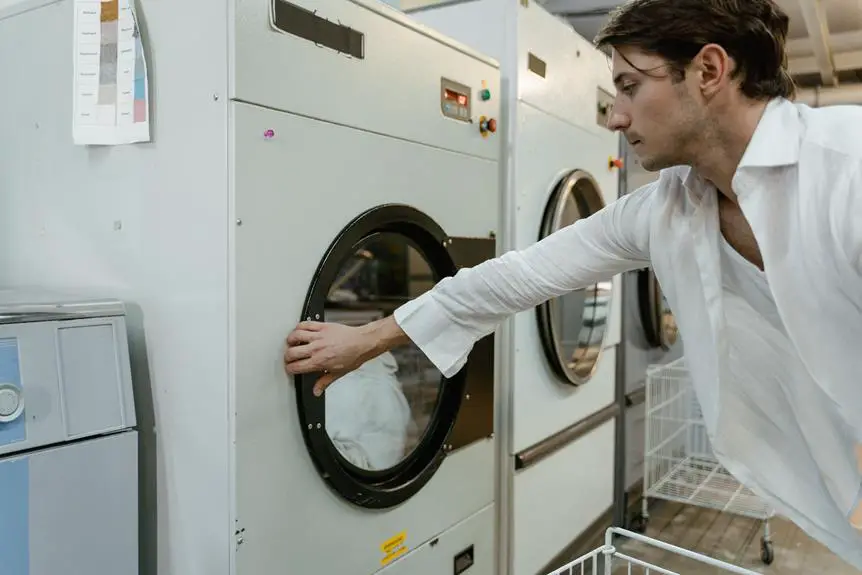Water found in a dryer typically indicates a problem with the appliance's ventilation. Common causes include a clogged exhaust vent, usually due to lint build-up or blockages, which traps moisture inside the dryer. Poor insulation around the dryer's exhaust ducts can cause condensation to form when there's a significant temperature difference, as seen in colder climates. Also, any damage to the vent duct, like holes or tears, can let outside water in.
Furthermore, mechanical issues such as a malfunctioning vent flap or faults in a condenser dryer's parts should be investigated. Rectifying these issues is crucial for the dryer to work efficiently and to extend its lifespan.
Blocked Exhaust Vent
A blocked exhaust vent in a dryer can cause water to accumulate inside the machine. This happens when lint, debris, or small animals block the vent pipe, or when the vent flap or cover is obstructed, preventing moist air from escaping.
To prevent this, it's important to regularly clean the dryer vent and check for any clogs. Keeping the vent duct, vent pipe, and the external vent flap or cover clear allows the moist air to be properly vented outside.
Additionally, inspect the vent ductwork for any holes or cracks, as these can let moist air leak out, causing condensation and possibly water damage.
Insufficient Ventilation Insulation
Insufficient insulation in a dryer's ventilation can cause moisture issues, such as water buildup in the dryer drum. Poorly insulated vents allow warm, moist air to cool quickly and condense, especially in cold areas or unheated spaces like basements.
This condensation can turn into water or ice and flow back into the dryer, creating excess humidity and water pools inside. Holes or cracks from poor insulation can worsen the problem by letting water into the dryer directly.
To prevent this, the dryer's exhaust duct should be properly insulated, particularly through colder areas. Wrapping the duct in insulation helps maintain even temperatures and reduce condensation.
Regular checks for vent damage can also prevent leaks that lead to moisture buildup. Proper insulation and maintenance of the dryer vent are key to avoiding moisture problems and keeping the appliance working effectively.
Vent Duct Damage
Vent duct damage must be addressed to prevent water buildup in dryers. Cracks or holes compromise airflow and lead to moisture issues. Regular inspections are necessary to maintain a functional exhaust system.
Damage to the vent duct can arise from impacts, corrosion, or wear and tear. Prompt repair or replacement of damaged duct sections is crucial to avoid moisture problems and to minimize lint buildup, which is a fire risk.
Condensation or ice near the vent or exhaust may signal that vent duct damage is impairing moisture expulsion. Inspect the duct carefully, particularly at connections and bends. Clean the lint trap regularly to prevent pressure on the ductwork and further damage.
Malfunctioning Vent Flap
A malfunctioning vent flap can cause water to collect in dryers. This flap is part of the exhaust system and allows moist air to exit during the drying process. If it's not working correctly, rain, ice, or snow could enter the vent and lead to water inside the dryer due to condensation or melting ice.
Common causes for a malfunctioning vent flap are debris buildup, damage, or deterioration over time. If the flap doesn't open as it should, it can't prevent condensation and may restrict airflow. This can cause moist air to condense in the vent pipe and water to accumulate in the dryer.
If a dryer leaks water, a blocked or damaged vent flap might be the reason. This should be addressed quickly to prevent further issues with the dryer.
To solve this problem, ensure the vent flap is clear and working properly. Replace it if it's found to be faulty. Regular maintenance of the vent system, including the vent flap, can prevent future condensation and water leaks, helping the dryer work efficiently.
Condenser Dryer Issues
Condenser dryers remove moisture from clothes by using warm air circulation. However, they can experience problems that lead to water buildup inside the machine.
A common issue is blocked ventilation, which can prevent moisture from reaching the collection tank. To prevent this, regularly clean the vent and ensure proper airflow.
Poor insulation of the exhaust duct, especially in cold areas, can cause condensation or ice formation, leading to water accumulation. Properly insulating ducts is necessary to avoid this problem.
Physical damage to the ducts, such as holes or cracks, may also result in water leakage. Inspecting and replacing damaged ducts is crucial for maintenance.
Lastly, problems with the condenser system, like leaking tanks or malfunctioning condensate pumps, can cause water to collect in the dryer. It's important to check that these parts are working properly to maintain the dryer's efficiency and prevent water issues.
Indoor Exhaust Setups
Indoor exhaust setups require proper ventilation to prevent moisture problems, such as water accumulation in dryers. When a dryer runs, it releases moist air. If the vent is blocked or not installed correctly, moisture can cause condensation in the laundry room and lead to water pooling in the dryer.
A common problem is using flexible vent hoses, which can kink and sag, creating areas for moisture to collect. Long hoses with many turns can also restrict airflow and increase moisture and lint buildup, raising the risk of water in the dryer and potential fire hazards.
To maintain indoor exhaust systems, regular cleaning to remove lint and debris is essential. The vent system should be designed for efficient air flow, using rigid metal ducts to lessen condensation and lint buildup risks.
In some cases, reconfiguring the exhaust setup to vent outside may be necessary. This can significantly reduce condensation issues. Proper duct insulation, particularly in areas with varying temperatures, can also help prevent moisture inside the dryer drum.
Ventilation System Misconfiguration
A misconfigured ventilation system can cause water to accumulate in dryers by preventing proper airflow. Blocked or incorrectly installed vents trap hot air, leading to condensation. This can result in water pooling inside the dryer or leaking onto the floor.
The issue often arises from a bent or compressed hose, or one clogged with lint. A bent hose can restrict airflow, and a lint clog can cause water to back up and condense. Regular inspection of the ventilation hose and external vent flap is important to ensure they are unobstructed and functional.
To avoid such problems, the dryer should have a straight, short vent hose to minimize the risk of blockages. Cleaning the hose with a vacuum or a dryer vent cleaning kit can help maintain airflow. Additionally, insulating the exhaust duct is crucial to prevent condensation and ice formation by keeping out cold air. Properly insulated and leak-free ductwork is essential for moisture to exit the dryer and prevent water buildup.




